Seeking the Structure of Matter
Ella Gordon and Dave Soper
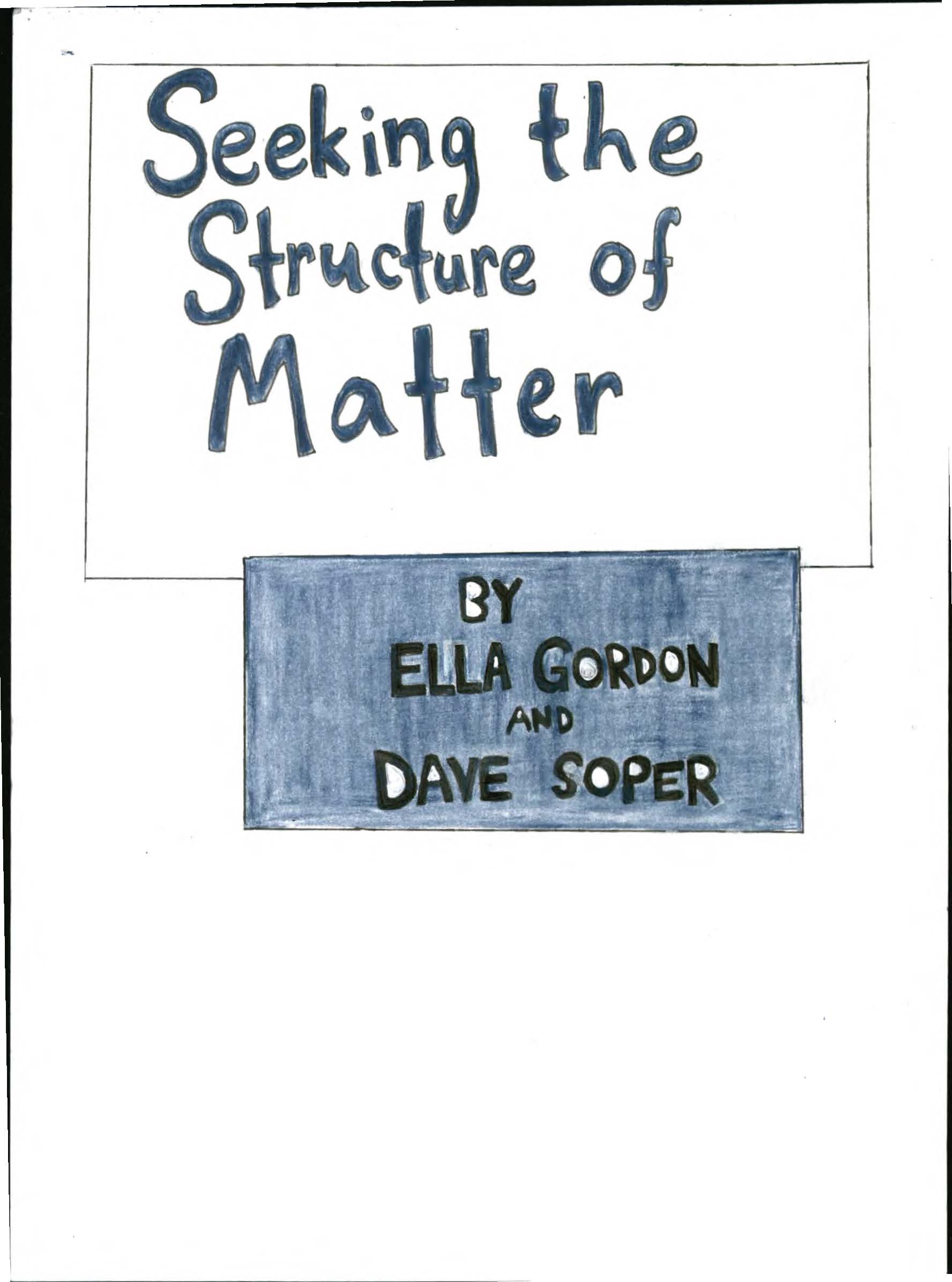
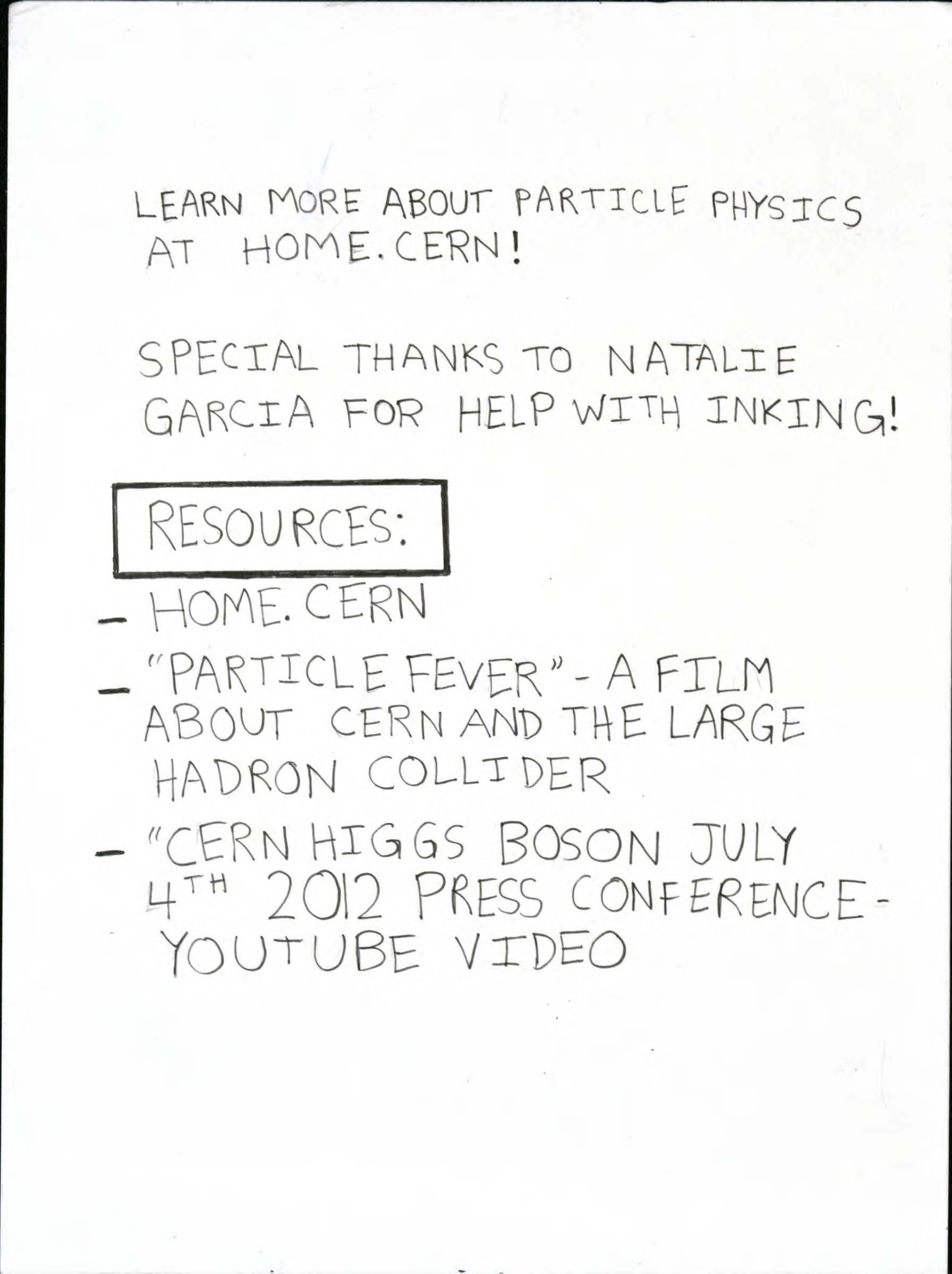
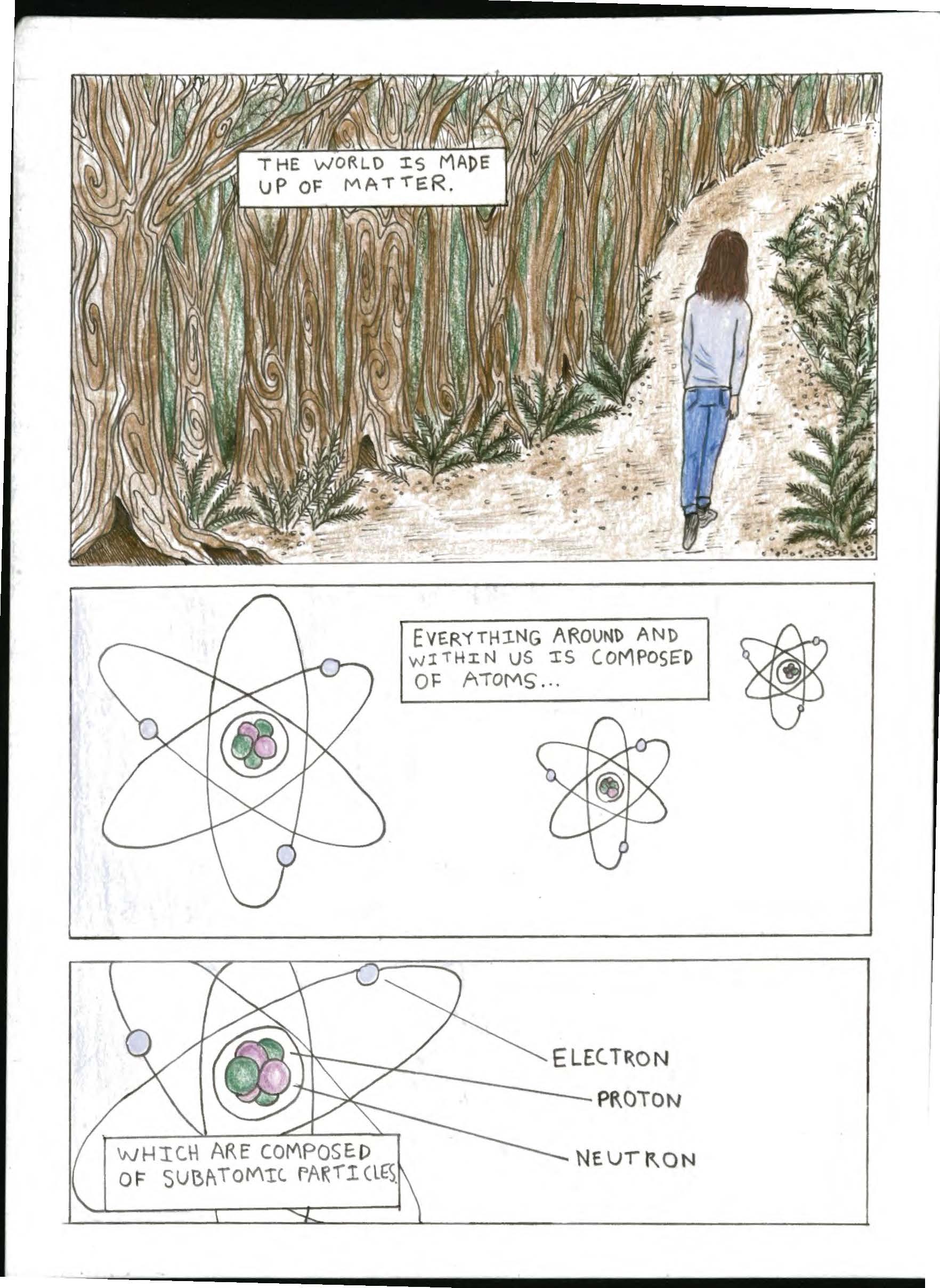
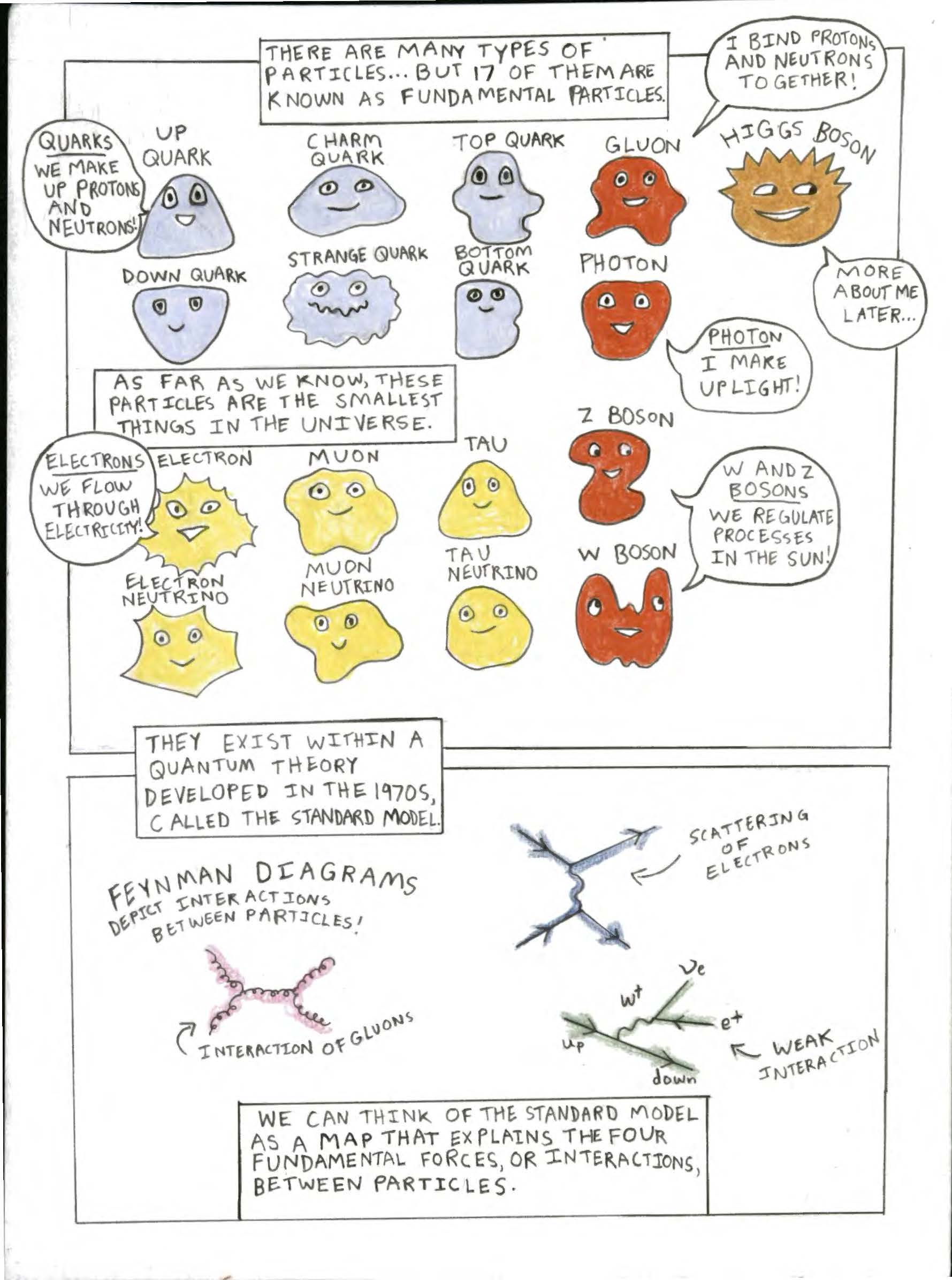
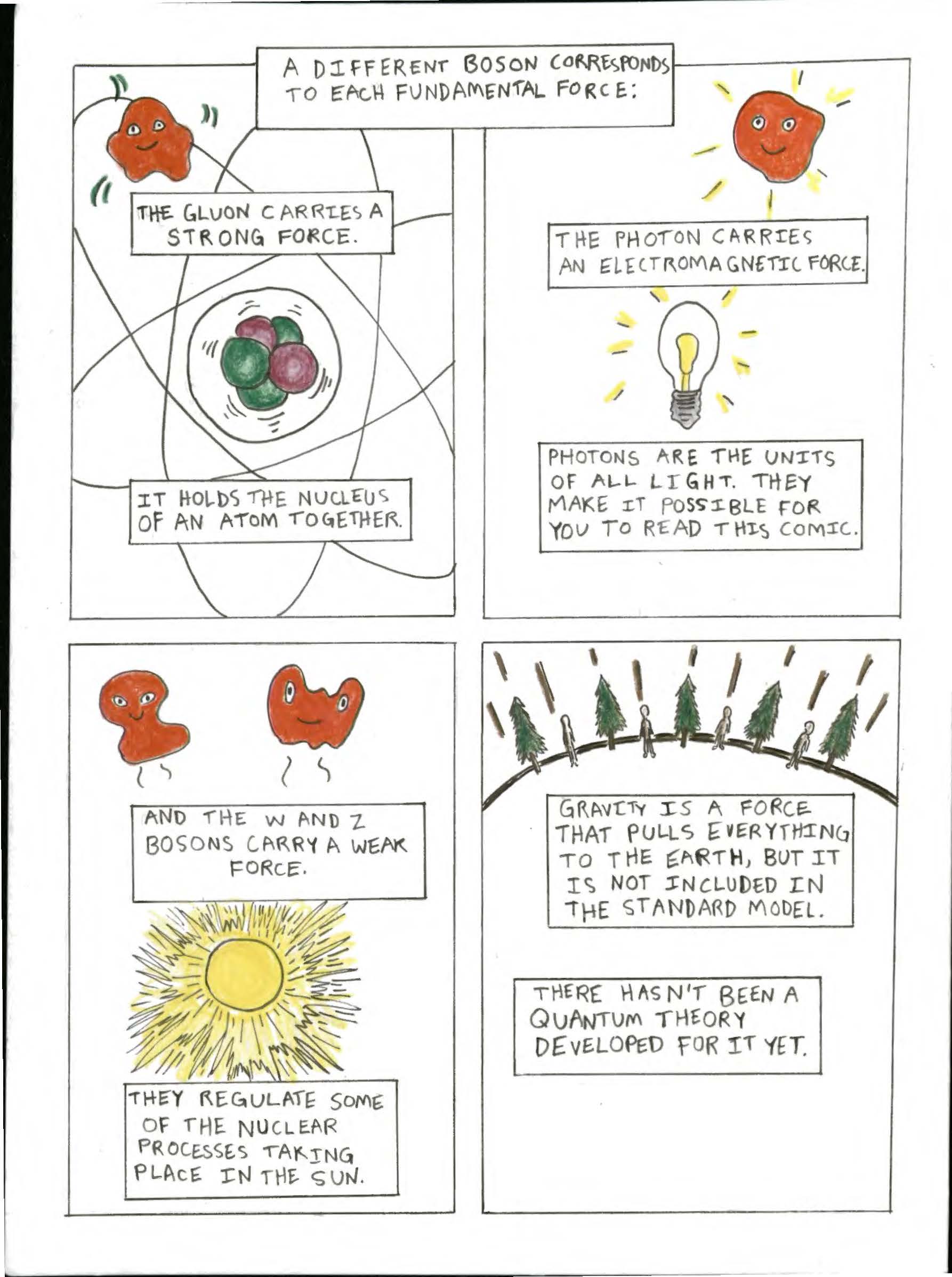
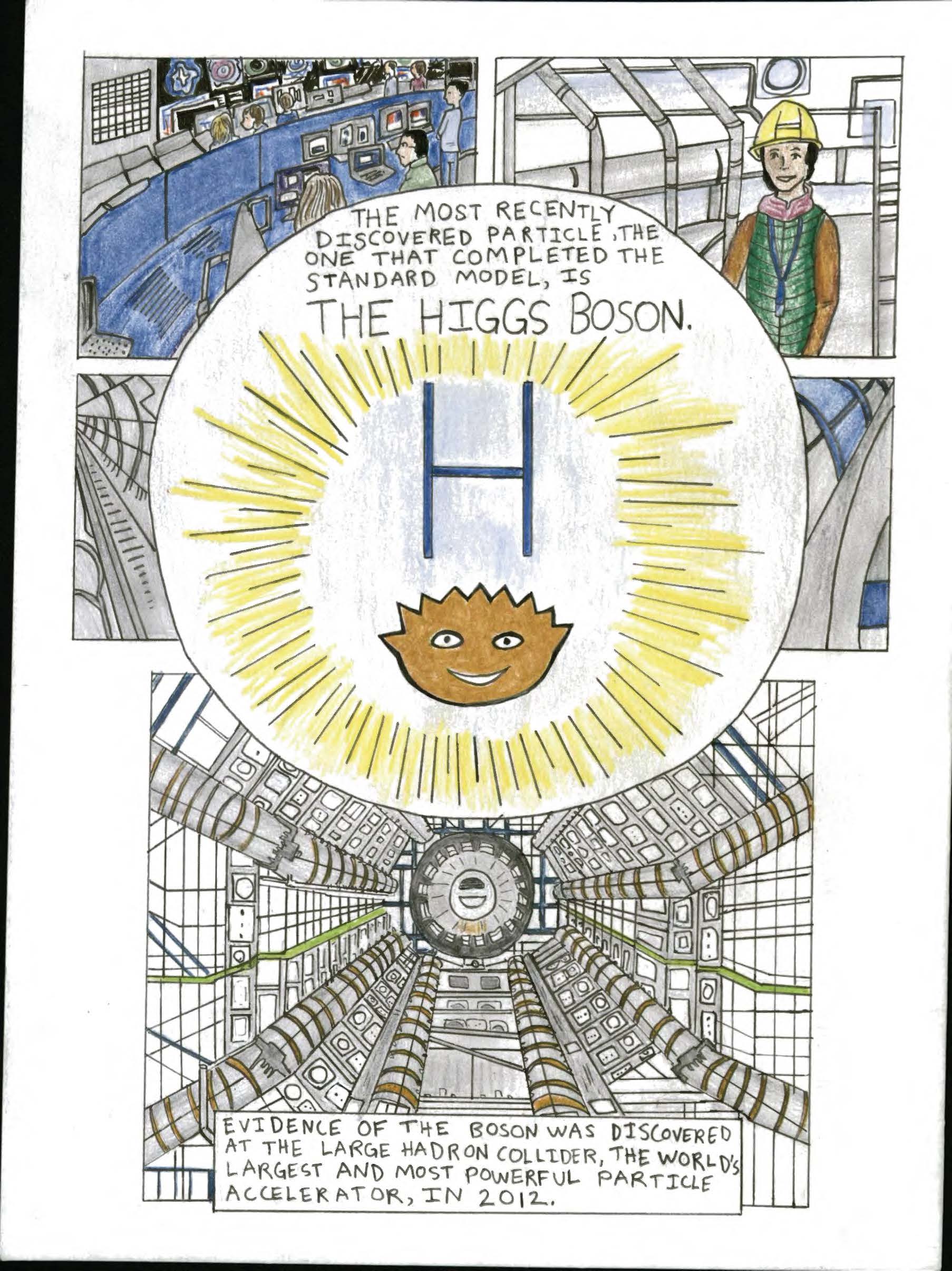
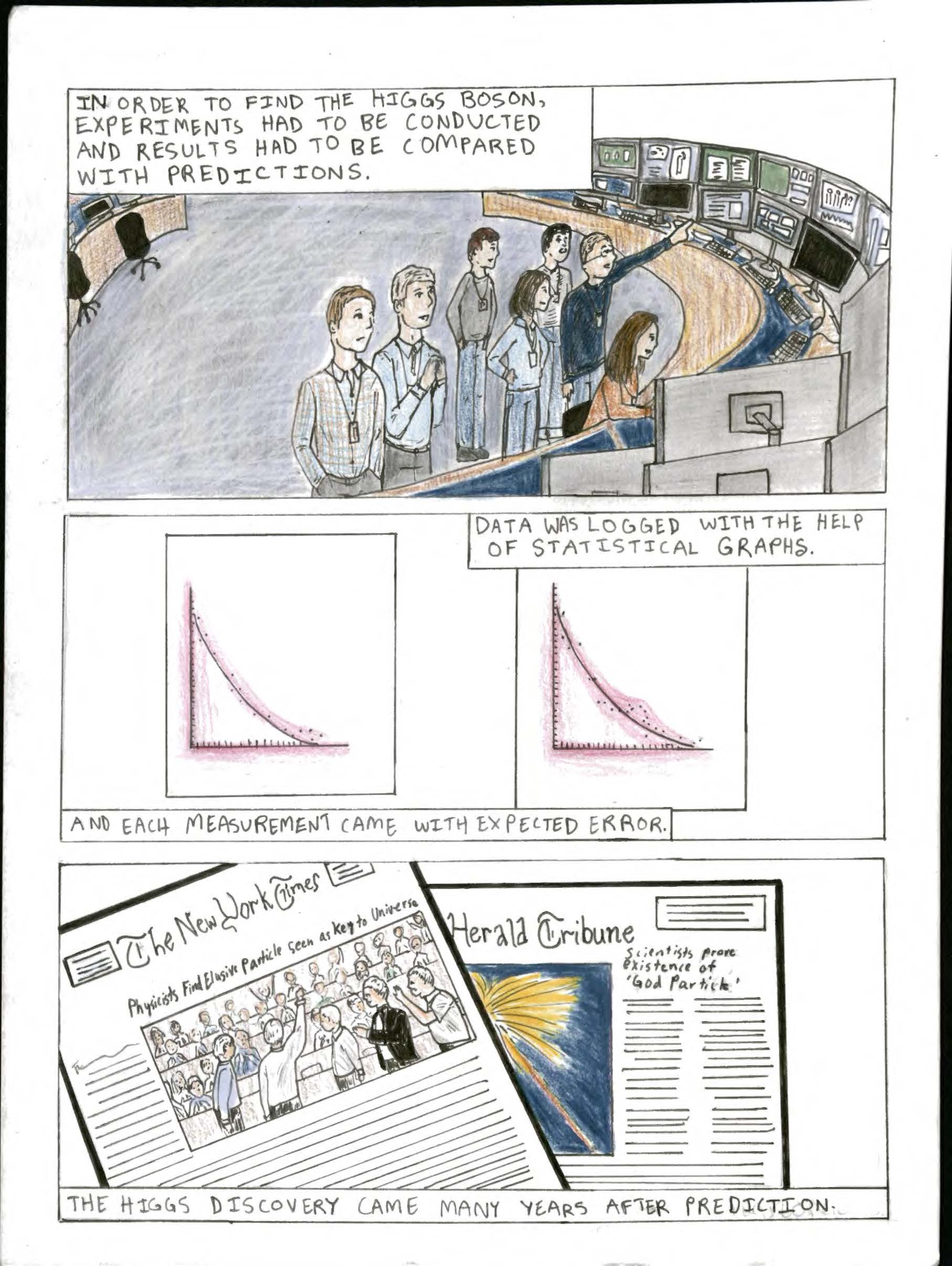
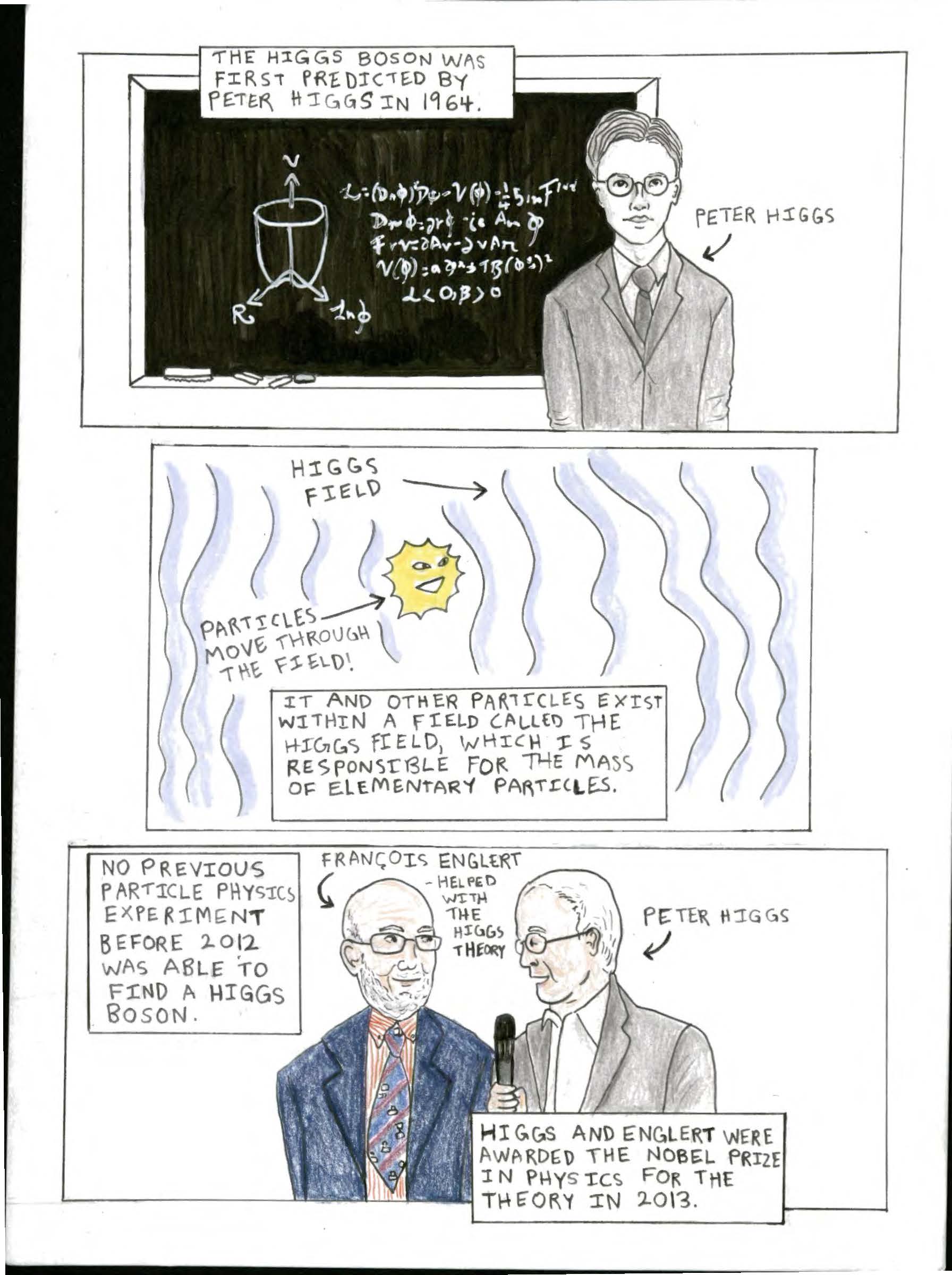
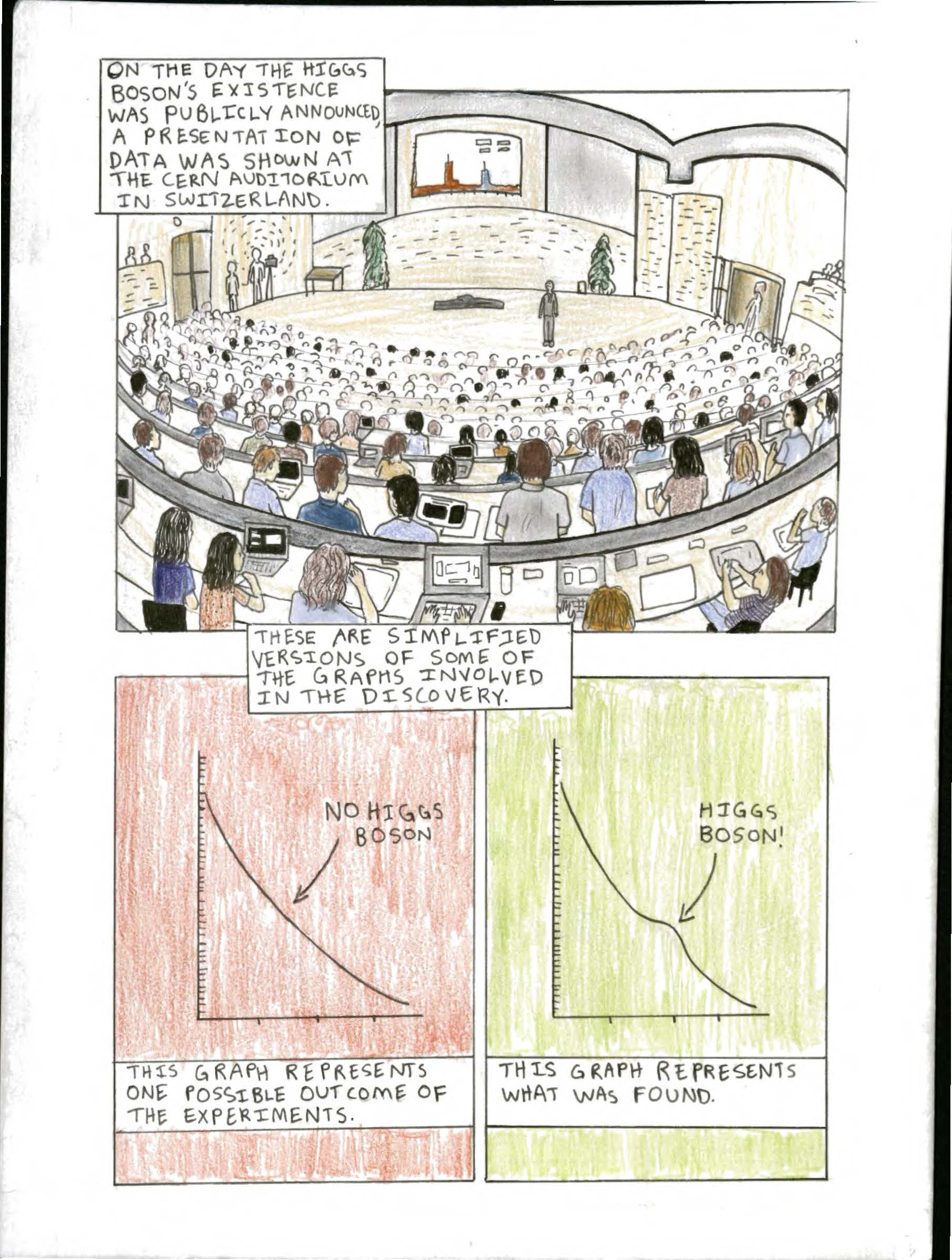
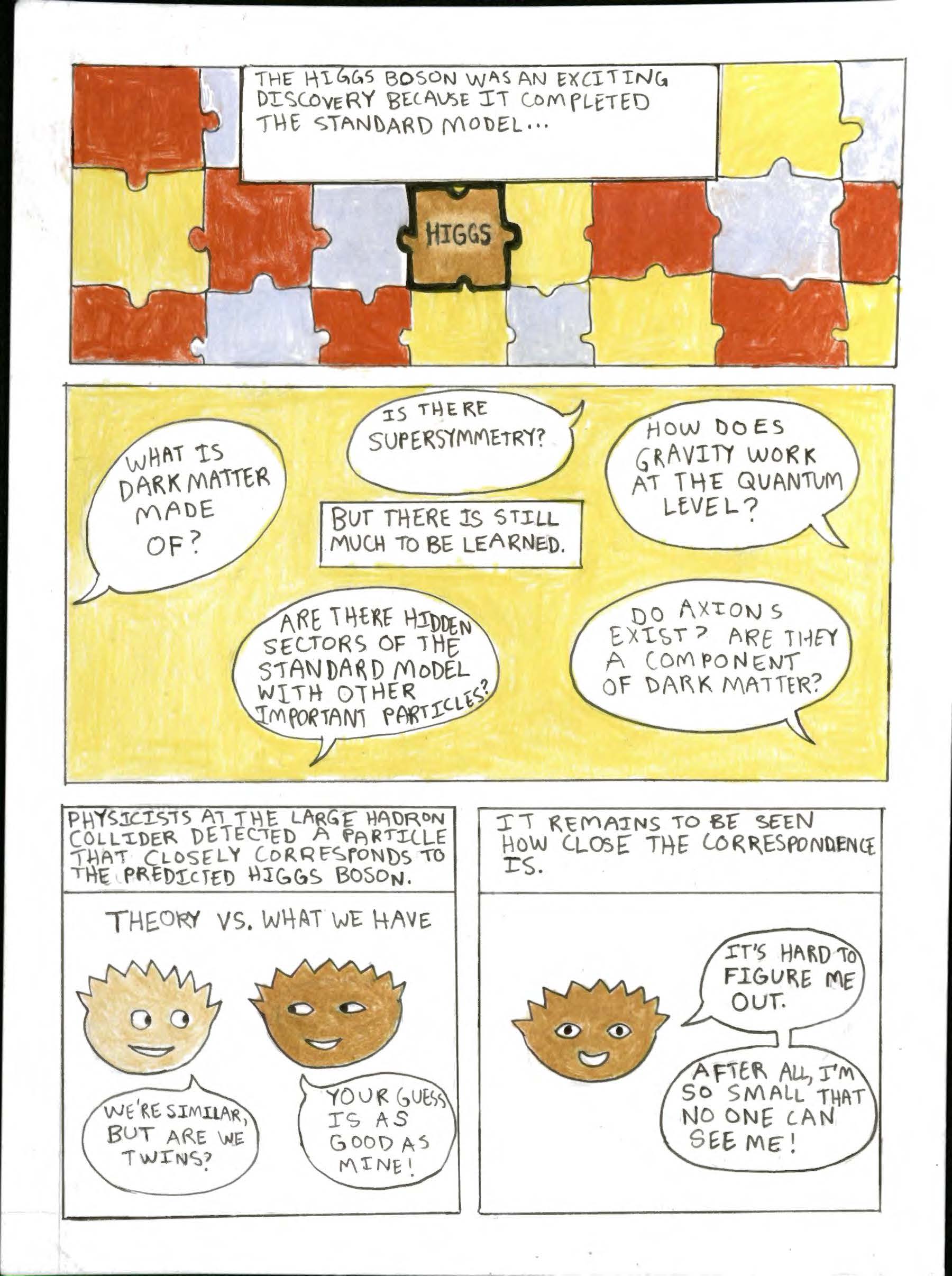
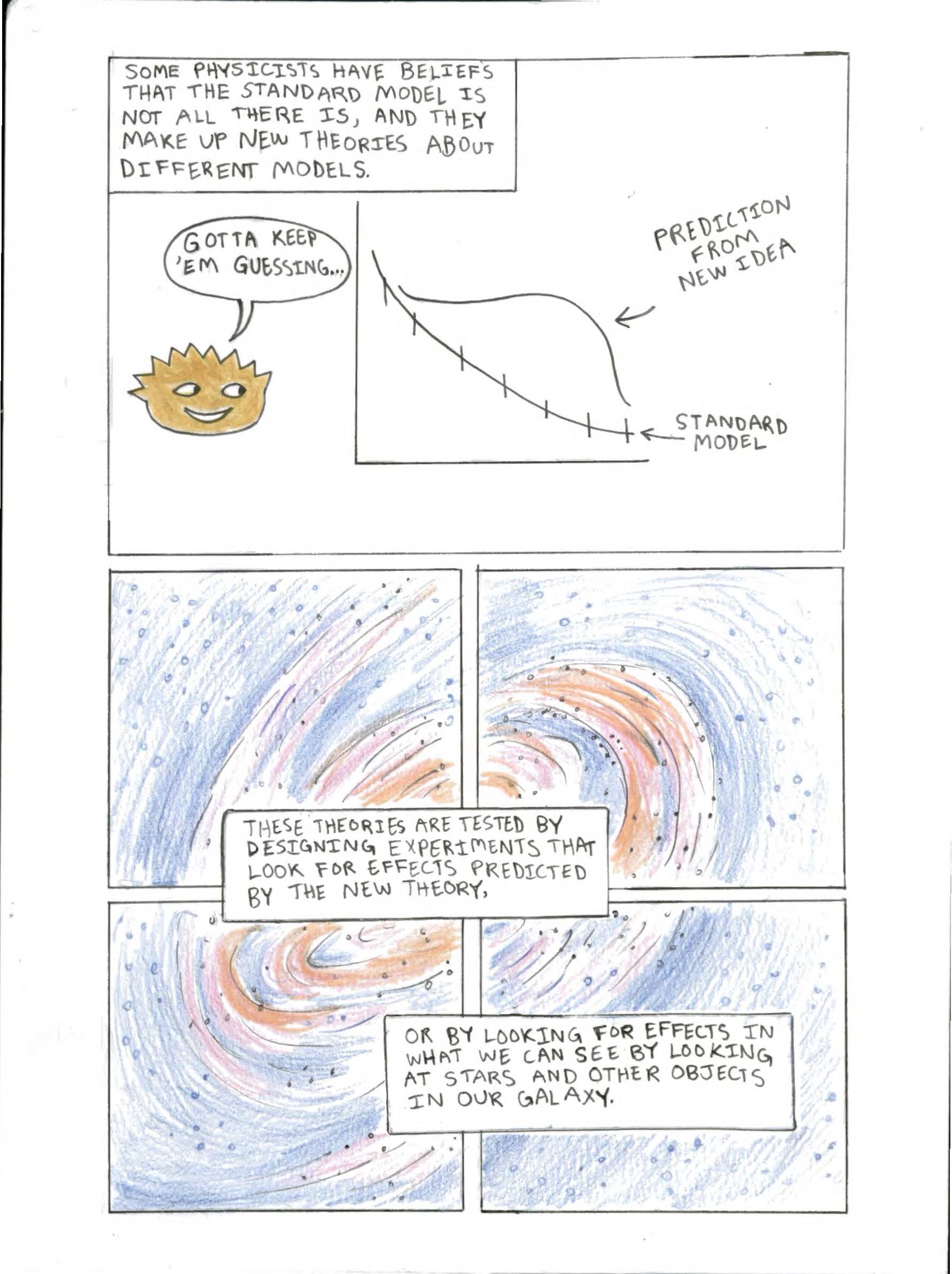
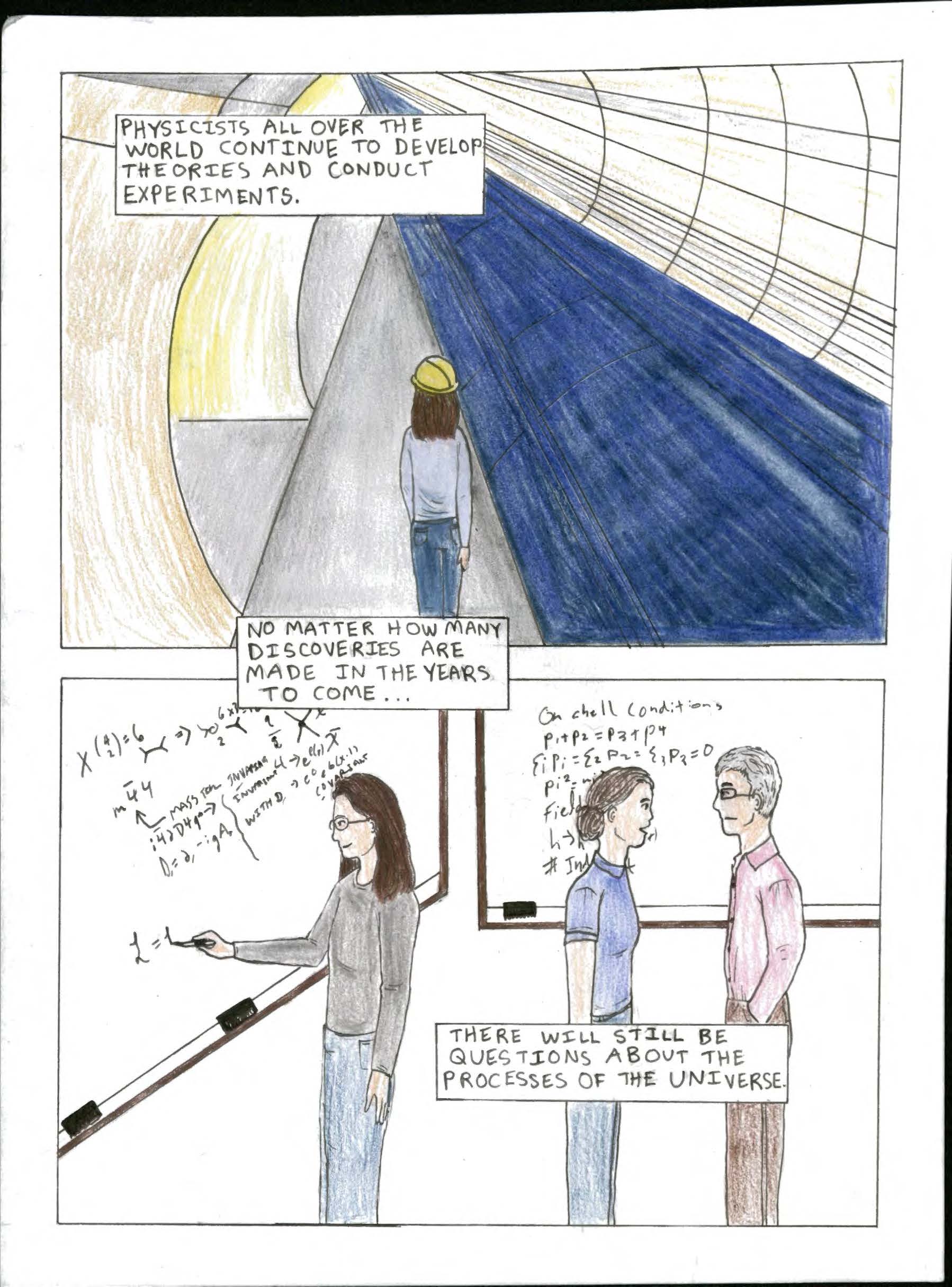
Transcript
Overview
A hand drawn, color pencil comic. The text is all caps, transcribed as sentence case for more accessible reading.
Cover
Seeking the Structure of Matter
By Ella Gordon and Dave Soper
Page 1
Learn more about particle physics at home.cern!
Special thanks to Natalie Garcia for help with inking!
Resources:
- Home.cern
- “Particle Fever,” A film about CERN and the Large Hadron Collider
- “CERN Higgs Boson July 4th 2012 Press Conference,” YouTube Video
Page 2
Panel 1: A white woman with shoulder length brown hair walks down a dirt path, her back to the reader. Surrounding the path are ferns and tall trees with swirling bark. “The world is made up of matter.”
Panel 2: Three diagrams of atoms float in the panel. The atoms have a nucleus and three electron shells orbiting around the nucleus. “Everything around and within us is composed of atoms…”
Panel 3: “Which are composed of subatomic particles.” A close up on an atom diagram, pointing out that the nucleus in the center is made of protons and neutrons, and that there are electrons in the shells orbiting the nucleus.
Page 3
Panel 1: This panel is full of atomic particles, each represented by a shape with a smile and eyes on it. All the particles are labeled, and some are speaking. The particles are color coded and arranged in a rough grid by type.
“There are many types of particles…but 17 of them are known as fundamental particles. As far as we know, these particles are the smallest things in the universe.”
Quarks: “We make up protons and neutrons!” (color coded blue)
- “Up Quark.”
- “Charm Quark.”
- “Top Quark”
- “Down Quark”
- “Strange Quark”
- “Bottom Quark”
Yellow particles:
- Electron. “Electrons we flow through electricity!”
- Muon
- Tau
- Electron neutrino
- Muon neutrino
- Tau neutrino
Orange particles:
- Gluon. “I bind protons and neutrons together!
- Photon. “Photon, I make up light!”
- Z Boson and W Boson: “W and Z Bosons: We regulate processes in the sun!”
Brown particle:
Higgs Boson: “More about me later…”
Panel 2:
“They exist within a quantum theory developed in the 1970s, called the standard model. We can think of the standard model as a map that explains the four fundamental forces, or interactions, between particles.”
“Feynman Diagrams depict interactions between particles!”
Three Feynman diagrams depict different interactions. One shows the interaction of gluons, another the scattering of electrons and a third shows a weak interaction.
Page 4
“A different boson corresponds to each fundamental force:”
Panel 1: “The gluon carries a strong force. It holds the nucleus of an atom together.” A diagram of an atom, impact line around the nucleus shows the force on it. A large gluon with a smiling face floats near the atom.
Panel 2: “The photon carries an electromagnetic force. Photons are the units of all light. They make it possible for you to read this comic.” A lightbulb and a photon float in the panel.
Panel 3: Two lumpy, oblong particles have small force lines coming off them. The sun shines brightly below the particles. “And the W and Z bosons carry a weak force. They regulate some of the nuclear processes taking place in the sun.
Panel 4: At the top of the panel is a semi-circle showing the curve of the Earth, with trees and people standing on it. “Gravity is a force that pulls everything to the Earth, but it is not included in the standard model. There hasn’t been a quantum theory developed for it yet.”
Page 5
The top half of this page has four small rectangular panels, and the bottom half has one large square panel. In the center of the page overlaying the other panels is a large circular panel.
Circular panel: “The most recently discovered particle, the one that completed the standard model, is the Higgs Boson.” A smiling Higgs Boson particle is below a large ‘H.’ Beams of light encircle the boson and ‘H.’
Panel 1: Researchers stand in a room filled with desks and screens looking at computers. The screens all show different colorful diagrams.
Panel 2: A researcher in a green puffy vest and a yellow hard hat stands in an industrial looking space.
Panel 3: most of this panel is covered by the circular panel, the part that is visible shows a long collider tunnel.
Panel 4: most of this panel is covered by the circular panel, the part that is visible shows an industrial looking area, possibly part of the tunnel.
Panel 5: A front view of the Large Hadron Collider, a tunnel with tubes and mechanical components on the floor, sides, and ceiling. “Evidence of the boson was discovered at the Large Hadron Collider, the world’s largest and most powerful particle accelerator, in 2012.”
Page 6
Panel 1: “In order to find the Higgs Boson, experiments had to be conducted and results had to be compared with predictions.” A group of researchers wearing lanyards stand in a large room with a circular bank of computers and monitors. One of the researchers points toward the screens.
Panel 2: “Data was logged with the help of statistical graphs. And each measurement came with expected error.” Two scatter plot graphs are positioned next to each other. They both have curved lines that plot the average of all the data points, one of the graphs has a pronounced bump along the lines where there are more data points.
Panel 3: “The Higgs discovery came many years after prediction.” Two newspaper front pages celebrate the discovery. The New York Times has a picture of researchers celebrating and the headline: “Physicists Find Evasive Particle Seen as Key to Universe”. The Herald Tribue has an image from the collider and the headline “Scientists Prove Existence of ‘God Particle.”
Page 7
Panel 1: “The Higgs Boson was first predicted by Peter Higgs in 1964.” Peter Higgs, a young man with neat hair and glasses wearing a suit, stands in front of a blackboard. The blackboard has a complicated equation and a diagram written on it.
Panel 2: “It and other particles exist within a field called the Higgs Field, which is responsible for the mass of elementary particles.” A Higgs field is represented by wavy lines, a particle moves through the field.
Panel 3: “No previous particle physics experiment before 2012 was able to find a Higgs Boson. Higgs and Englert were awarded the Nobel Prize in physics for the theory in 2013.” Two older men stand next to each other. “François Englert helped with the Higgs theory” he wears a striped shirt, blazer, and tie, he is balding with a grey beard. Peter Higgs is holding a microphone and wears a grey blazer and button-down shirt.
Page 8
Panel 1: “On the day the Higgs Boson’s existence was publicly announced, a presentation of data was shown at the CERN auditorium in Switzerland.” A man stands on stage in a large auditorium with tiered seating full of people on laptops.
Panel 2: “These are simplified versions of some of the graphs involved in the discovery.” The panel is shaded orange. A simple line graph with an x and y axis is labeled “no Higgs Boson.” The graph shows a line that starts near the top of the y axis and curves down toward the end of the x axis. The line is a smooth curve. “This graph represents one possible outcome of the experiments.”
Panel 3: This panel is shaded lime green and shows a second, similar graph. This graph is nearly identical but there is a pronounced bump in the curve about halfway down the line. The bump is labeled “Higgs Boson!” “This graph represents what was found.”
Page 9
Panel 1: “The Higgs Boson was an exciting discovery because it completed the standard model…” This panel is tiled with colored puzzle pieces matching the colors of the particles in the rest of the comic, a highlighted puzzle piece in the center is a different color than the others and is labeled “Higgs.”
Panel 2: “But there is still much to be learned.” This panel is blank, except for five speech bubbles, with questions coming from all directions:
- “What is Dark Matter made of?”
- “Is there supersymmetry?”
- “How does gravity work at the quantum level?”
- “Do axions exist? Are they a component of dark matter?”
- “Are there hidden sectors of the standard model with other important particles?”
Panel 3: “Physicists at the Large Hadron Collider detected a particle that closely corresponds to the predicted Higgs Boson.” Two particles glance at each other sideways, they are both shaded brown like the other Higgs Boson particles in the comic, except one is a lighter brown, they are labeled: “Theory vs. What we have” They speak to each other: “We’re similar, but are we twins?” “Your guess is as good as mine!”
Panel 4: “It remains to be seen how close the correspondence is.” A single Higgs Boson speaks, “It’s hard to figure me out. After all, I’m so small that no one can see me!”
Page 10
Panel 1: “Some physicists have beliefs that the standard model is not all there is, and they make up new theories about different models.” A Higgs Boson particle says, “Gotta keep ‘em guessing…” A graph shows the standard model, a concave curve similar to the previous graphs, another curve on the same graph is labeled “predication from new idea” that curve is has a very pronounced bump, making it convex.
Panel 2-5: One image of a colorful swirling galaxy is split into four smaller square panels. “These theories are tested by designing experiments that look for effects predicted by the new theory, or by looking for effects in what we can see by looking at stars and other objects in our galaxy.”
Page 11
Panel 1: “Physicists all over the world continue to develop theories and conduct experiments.” The woman from the first panel, now wearing a hard hat, stands in a large collider. The collider is rendered simply with bold geometric lines.
Panel 2: “No matter how many discoveries are made in the years to come…there will still be questions about the processes of the universe.” Three scientists stand in a room with large white boards. The woman from the first panel is writing a complex equation on a white board while the other two scientists talk to each other.
